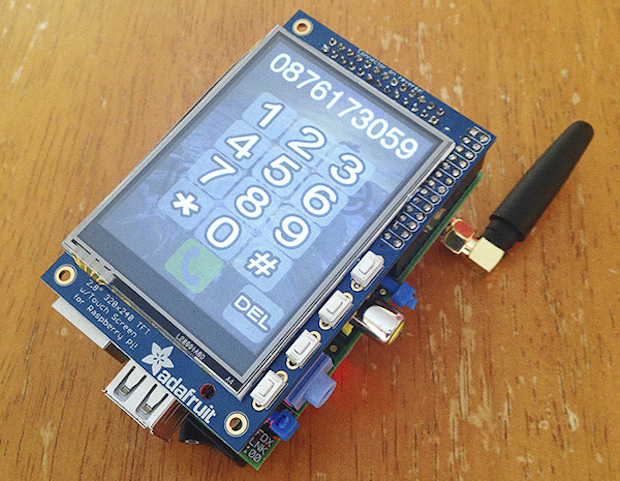Raspberry Pi used to create a £90 smartphone
PiPhone created using freely available components


An engineer has managed to build a smartphone using a Raspbery Pi computer and off-the-shelf components.
David Hunt, from Limerick in the Republic of Ireland, created the touchscreen-enabled device for less than 100.
Hunt said the phone, built to teach basic computer skills in schools, was made with off-the-shelf components with no soldering required. In addition to the Raspberry Pi board (model B), the phone sports a 320 x 240 touchscreen, a 2500mAh battery and a Sim900 GSM/GPRS module which enables the device to call, send texts and use data services..
Dubbed the "PiPhone", the device can make and receive calls and could be capable of more advanced functions more commonly associated with smartphones, such as apps, should the wider Raspberry Pi community write them.
"It's more of a proof of concept to see what could be done with a relatively small form factor with off-the-shelf (cheap) components," said Hunt in a blog post.
"I don't expect everyone to be rushing out to build this one, but I had great fun in doing it."
The two most expensive items to make the phone was the Raspberry Pi board ($40) and the sim module ($48). The rest of the components made up the $158 (94) cost. He added that despite the cost of the phone, most people would be better off buying a normal smartphone.
Sign up today and you will receive a free copy of our Future Focus 2025 report - the leading guidance on AI, cybersecurity and other IT challenges as per 700+ senior executives
Hunt said that when he presented the finished device at a local engineering club, he was asked if he had to pay for credit to use the phone.
"That certainly made me think, and we had a good giggle at that. Yes, you still have to pay for credit in the usual way, purchase a SIM card from a local service provider. This is not going to get you free calls!" he said.
Rene Millman is a freelance writer and broadcaster who covers cybersecurity, AI, IoT, and the cloud. He also works as a contributing analyst at GigaOm and has previously worked as an analyst for Gartner covering the infrastructure market. He has made numerous television appearances to give his views and expertise on technology trends and companies that affect and shape our lives. You can follow Rene Millman on Twitter.
-
 Two Fortinet vulnerabilities are being exploited in the wild – patch now
Two Fortinet vulnerabilities are being exploited in the wild – patch nowNews Arctic Wolf and Rapid7 said security teams should act immediately to mitigate the Fortinet vulnerabilities
-
 Coursera and Udemy eye AI training dominance in $2.5bn merger
Coursera and Udemy eye AI training dominance in $2.5bn mergerNews The deal between Coursera and Udemy will create a $2.5bn company to help workers learn AI – and retrain for jobs replaced by it
-
 Arm acquires stake in Raspberry Pi in bid to drive IoT development
Arm acquires stake in Raspberry Pi in bid to drive IoT developmentNews The deal confirms a long-standing Raspberry Pi commitment to Arm chips
-
 Raspberry Pi 5: New model is “2-3 times more powerful” than previous generation
Raspberry Pi 5: New model is “2-3 times more powerful” than previous generationNews The new Raspberry Pi 5 will provide a “no-compromise user experience”, the firm said
-
 Sony invests in Raspberry Pi to strengthen edge AI offering
Sony invests in Raspberry Pi to strengthen edge AI offeringNews The move follows longstanding ties between the two firms
-
 Return of the Mac
Return of the MacIn-depth Developer Jarosław Mazurkiewicz explains the creative process behind MacintoshPi and why he wanted to bring a classic Mac back to life
-
 Raspberry Pi ten years on: Breathing new life into retro machines
Raspberry Pi ten years on: Breathing new life into retro machinesIn-depth A full decade after the Raspberry Pi first hit shelves, the microcomputer is reviving older PCs and games consoles
-
 The IT Pro Podcast: Turning developers into craftspeople
The IT Pro Podcast: Turning developers into craftspeopleIT Pro Podcast Making software is about much more than pushing code, explains Raspberry Pi founder Eben Upton
-
 What is the Raspberry Pi Pico?
What is the Raspberry Pi Pico?In-depth Introducing the latest $4 member of the family of single-board microcomputers
-
 Raspberry Pi 4 gets an official case fan
Raspberry Pi 4 gets an official case fanNews The £4.50 fan will prevent the board's ARM Cortex-A72 processor from overheating
